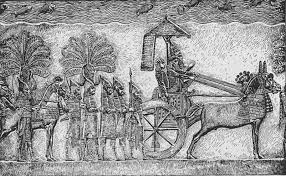The Timeline of Sennacherib’s Invasion of Judah

An accurate understanding of Sennacherib’s invasion of Judah, his temporary military campaign into Egypt, then his return and destruction in Jerusalem can be confusing without a timeline. It is based on biblical accounts, but I have also used some secular reports to create a clearer picture of what really took place (to see link click Gw – Then the Angel of the LORD Put to Death a Hundred and Eighty Five Thousand Men in the Assyrian Camp). The main reason that a timeline is needed, is to explain how 185,000 Assyrians could die in a single night (37:36).
1. Sennacherib invades Judah through conquered Isra’el from the north.
2. He divides his army in half. One army goes down the coast to defeat the Philistines, while the other goes down the center of Judah to Lachish.
3. In the meantime, Edom, Mo’ab, and Amon surrender and are no longer a threat to him.
4. While Sennacherib lays siege to Lachish, a city in the countryside, Hezekiah strikes for peace and sends him tribute. But Sennacherib decides to take Jerusalem anyway, and sends his Field Commander to Jerusalem to demand an unconditional surrender.
5. Unsuccessful, the Field Commander returns empty-handed to Sennacherib because he could not convince Hezekiah to surrender.
6. By this time Lachish had fallen and Libnah was besieged. At this point, news reached Sennacherib that an Egyptian-Ethiopian invasion under King Tirhakah had begun.
7. Feeling very confident, Sennacherib writes a letter to Hezekiah telling him that his God could do nothing to prevent the destruction of Jerusalem and her people.
8. Sennacherib meets and defeats King Tirhakah at Eltekeh in southern Palestine.
9. With Egypt helpless before him, Sennacherib seizes the advantage and crosses the Egyptian border and receives a declaration of surrender.
10. While in Egypt, God sent a plague spread by mice that infected the Assyrian army.
11. Having conquered Egypt, Sennacherib now turned his attention back to Jerusalem.
12. As Sennacherib and his army returned to Jerusalem his army came down with the aforesaid wasting disease.
13. On the first night of the siege, a hundred and eighty-five thousand men in the Assyrian camp died (37:36). The Light of Israel became a fire, their Holy One a flame; in a single night it burned and consumed his foot soldiers and generals (10:17). They were infected in Egypt, but they died several days later outside Jerusalem.
14. He did not set foot in Jerusalem, nor was he able to surround it.



Leave A Comment